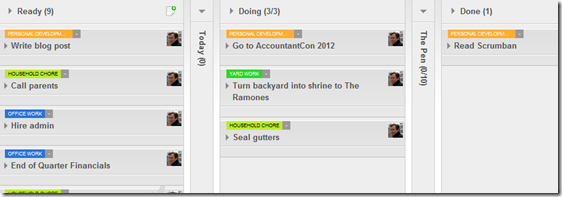Step 1 - Seiri
Seiri means as much as cleaning, throwing your junk away, and in a certain way, this is what you need to do when implementing your Personal Kanban. If you have used (or still use) different ways of keeping track of your tasks, get rid of them. No scribbles next to your keyboard, no sticky notes next to your phone, no random reminders in your mobile phone. Do a spring clean, if it's a task, put it in your Personal Kanban (the backlog, if it's for later on), if it's useless information, dump it. Make sure that there is only one place for you that contains all the information you need.
Step 2 - Seiton
Seiton means to bring things in order so you can use your Personal Kanban efficiently. It doesn't matter if you are using a big whiteboard, a table or your office door but whatever you use, you should have everything you need accessible. Stock up on post-it notes in different colours, have pens at hand, maybe even a filer so you can store your finished tasks for later. Whatever it is, you should not have to search for it when you want to work with your Personal Kanban, and the tools should neither be far away nor in an uncomfortable position. A corner in your room for example is a bad idea, as I guarantee that you'll lose your motivation if you constantly have to bend down to get a new post-it note.
Step 3 - Seiso
Seiso means to clean things or to shine them. This does not only mean that you should regularly take a cloth and scrub your whiteboard, if you have one, as noone likes dirt and dust. The bigger part of this means that you should keep your Personal Kanban tidy and in good shape. At the end of your workday, take a look at it, and ask yourself whether it is still a representation of your work. If tasks have become obsolete, then mark them as done. If you like to make notes to your tasks for later retrospectives, then now it's the time to do so. Rearrange what's left, reorder, make it look good. These minutes are not a lot of effort but if you start the next morning with a clean and up-to-date Kanban, you will feel better than if you had to start your day with cleaning things up first.
Step 4 - Seiketsu
Seiketsu is the task of standardizing things. Define for yourself a method for your Personal Kanban, and stick to it. If you use different colours or shapes for different kinds of things then be consistent with it. If you usually categorize doing your dishes as house chore, don't suddenly use a different category just because you couldn't find a post-it of the correct colour at hand. If you like to add deadlines to task items, make sure that each task with a deadline is marked accordingly. You want to be able to rely on the information your Personal Kanban gives you to make your decisions.
Step 5 - Shitsuke
Shitsuke means to sustain things and to be disciplined. Pay attention to the four steps above regularly. Use your Personal Kanban. Keep things clean and tidy, stick with the system you defined for yourself, restock on tools and whatever you need. And, above all: commit to what you are trying to achieve. Without discipline, your method will deteriorate over time and you'll gradually fall back into your way you worked before you introduced Personal Kanban. With discipline you will not only maintain but also over time improve your flow (through Kaizen), and you will have more often successful days when you see what you've done.
Conclusion
Most likely, all of the five steps mentioned above will sound obvious to you. For me, personally, they have formed a ritual and a mindset that help me maintain order and stability in my Personal Kanban, which leads to clarity and allow me to make the right decisions.





